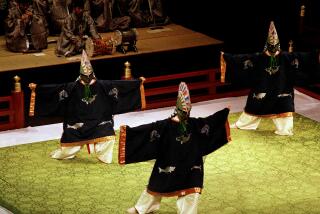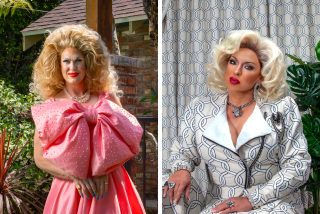DANCE REVIEW : ‘Black Choreographers’ at Wadsworth
- Share via
Seventeen months ago, a festival titled “Black Choreographers Moving Toward the 21st Century” arrived in Los Angeles and San Francisco determined to influence the future of American dance. Judging by the subsequent careers of Bill T. Jones and Alonzo King (among others), its aim was right on target.
A new edition, under different leadership, returned to the Wadsworth Theater on Thursday looking far more conservative. Most of the five-part program reflected the limited view of black dance popularized by the Alvin Ailey American Dance Theatre--a company that, ironically, will bypass Los Angeles in its Southern California engagements next week.
In a forceful new production by Los Angeles Contemporary Dance Theater, Donald McKayle’s 1972 “Songs of the Disinherited” created compassionate character sketches from a wide range of movement resources: stylized gesture, linear jumps, deeply sculpted torso motion, etc. But the suite too quickly changed from social portrait to celebratory showpiece, with the finale more than ever an evasion.
Performed with relentless bravado by Dayton Contemporary Dance Theater, “Urban Folk Dance” represented Ulysses Dove’s latest essay in choreographic sex war: this quartet more insightful about the women casualties of such combat than his “Bad Blood,” but just as obsessed with high-risk gymnastics.
Nia Love-Pointer’s duet “The First Lesson” shared some of Dove’s stylistic priorities--but defined its meanings solely through sermonizing program notes, a similarly intimidating recorded text, florid emoting and the year’s most ridiculous coup de theatre --an ascending, illuminated fetus. The dancing? Merely a generalized gloss on all the theatrical overkill.
The works by McKayle, Dove and Pointer all projected technical fireworks and role-playing at the audience, straining to impress. In contrast, pieces by David Rousseve and Bebe Miller invited the audience along on intimate, intense voyages of discovery, trusting that we’d understand.
Rousseve’s visionary “Colored Children Flyin’ By” again mixed personal anecdotes about race relations with spoken and danced evocations of his grandmother’s life and persona. But here (more than in his site-specific event at the Bradbury Building last Sunday), Rousseve assumed the voice of Thelma Arceneaux in order to redream her dreams and, in a daring act of transference during his final nude solo, even embody them. A dancer’s quantum leap.
The Jimi Hendrix recordings used for Miller’s latest work clearly inspired her and her company to a level of sheer physical heroism innovative all by itself. From Miller’s opening solo to the final duet for Scott Smith and Earnie Stevenson, “The Hendrix Project” plunged deep and flew high, with constant, supercharged shifts in level, direction, scale and impetus played out on a floor piece that looked like a giant game board.
Miller’s solo to “Like a Rolling Stone” gloried in bravura eccentricity: urgent reaches that terminated in sudden twists or curls, jumps that melted into turns, teetering body-squiggles and mock-exhaustion that Miller suddenly dumped at song’s end for drop-dead steadiness in extension.
Multiply this activity sevenfold and you can guess at the unbelievable complexity of her ensemble choreography--but not its superb, interlocking sense of flow or the spontaneous gymnastic interplay.
Don’t look now, folks, but the 21st Century just arrived and it’s at the Wadsworth through Sunday.
More to Read
The biggest entertainment stories
Get our big stories about Hollywood, film, television, music, arts, culture and more right in your inbox as soon as they publish.
You may occasionally receive promotional content from the Los Angeles Times.










